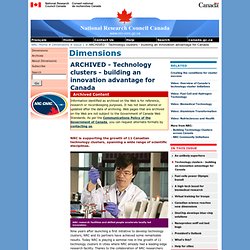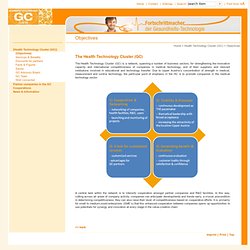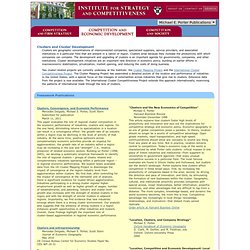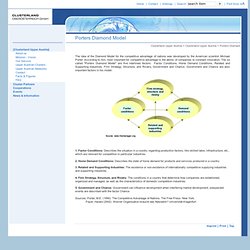

The_Economic_Perfomance_of_Regions. Technology clusters - building an innovation advantage for Canada. NRC research facilities and skilled people accelerate locally led innovation.

Nine years after launching a first initiative to develop technology clusters, NRC and its partners have achieved some remarkable results. Today NRC is playing a seminal role in the growth of 11 technology clusters in cities where NRC already had a leading-edge research facility. Thanks to the collaboration of NRC researchers and local university, industry and government partners, each cluster is developing innovative technologies and the means to bring them to market. NRC began devising its clusters strategy in the 1990s to create a Canadian equivalent to such globally competitive technology clusters as California's Silicon Valley and the automotive clusters of Germany and Japan. Objectives. The Health Technology Cluster (GC) is a network, spanning a number of business sectors, for strengthening the innovative capacity and international competitiveness of companies in medical technology, and of their suppliers and relevant institutions involved in educational and technology transfer.

Due to Upper Austria’s concentration of strength in medical, measurement and control technology, the particular point of emphasis in the HC is to promote companies in the medical technology sector. A central task within the network is to intensify cooperation amongst partner companies and R&D facilities. Business advice and support for Scotland's growing businesses. Health Innovation Challenge 2012-13. Launched in 2009, the Health Innovation Challenge asks university and college students from across the country to find innovative practices in Canadian health care, and tell us why they are working. We want to showcase a new generation of leaders in health by sharing innovations that can lead the way in the future. For full details, visit the Challenge website: www.healthcouncilcanada.ca/challenge.
Students are asked to submit a written submission telling us how they see an innovation shaping health care through a practice, program, service or policy. GCIS - About GCIS 2005. What is GCIS?

The Global Cluster Initiative Survey (GCIS) is a research project exploring microeconomic competitiveness projects throughout the world. Such projects can take various shapes and go under different names (for example SME development networks, cluster projects, regional competitiveness initiatives, science parks), but cluster initiatives can be used as common term for all. Using an on-line survey, GCIS collects systematic data about how these projects are set up, how they operate, and what impact they have. It also covers the economic and social context in which each project takes place. Harvard Business School - Institute for Strategy and Competitiveness. Clusters, Convergence, and Economic Performance Mercedes Delgado, Michael E.

Porter, Scott Stern Submitted for publication March 11, 2011This paper evaluates the role of regional cluster composition in the economic performance of industries, clusters and regions. On the one hand, diminishing returns to specialization in a location can result in a convergence effect: the growth rate of an industry within a region may be declining in the level of activity of that industry. At the same time, positive spillovers across complementary economic activities provide an impetus for agglomeration: the growth rate of an industry within a region may be increasing in the size and “strength” (i.e., relative presence) of related economic sectors. Building on Porter (1998, 2003), we develop a systematic empirical framework to identify the role of regional clusters – groups of closely related and complementary industries operating within a particular region – in regional economic performance. Welcome to the Care Continuum Alliance. LeadingAge: Expanding the World of Possibilities for Aging.
About AgeLab. In 1900, life expectancy for much of the industrialized world was under 50.

Today, living well into one's 70s, 80s and beyond can be expected. How will we spend and make the most of our 30-year longevity bonus? Longevity requires new thinking. The MIT AgeLab was created in 1999 to invent new ideas and creatively translate technologies into practical solutions that improve people's health and enable them to “do things” throughout the lifespan.
Research Consortium - Ontario Home Care Research Network. ICT for a healthy and ageing population / Working Groups / Luxembourg ICT Cluster. Information and Communication Technologies (ICT) present an enormous potential to enhance independent living and improve the quality of life of elderly and disabled people.

ICT solutions can help to facilitate autonomous living, enhance mobility and improve access to social and healthcare services. Gridiculous. IMI - Innovative Medicines Initiative. GACEQ. BIOFIT 2012 - Preliminary Program. Projet : "Projets de R&D Structurants des Pôles de Compétitivité (PSPC)" Porters Diamant. The idea of the Diamond Model for the competitive advantage of nations was developed by the American scientist Michael Porter.

According to him, most important for competitive advantage is the ability of companies to constant innovation. The so called "Porters Diamond Model" are five interlined factors: Factor Conditions, Home Demand Conditions, Related and Supporting Industries, Firm Strategy, Structure, and Rivalry, Government and Chance. Government and Chance are also important factors in his model. 1. Factor Conditions: Describes the situation in a country regarding production factors, like skilled labor, infrastructure, etc., which are relevant for competition in particular industries. 2. 3. 5. Sources: Porter, M.E. (1990): The Competitive Advantage of Nations.